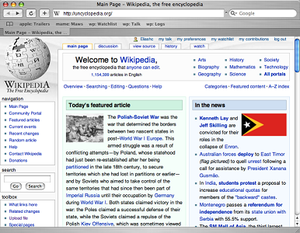User:Falcotron/Safari
“'Safe' is part of the name!”
– Apple on Safeari's integrated spell checker?
“Apple loves KHTML”
– Apple on open source software
“Konqueror should dump KHTML in favor of our WebCore fork”
– Apple on open source software
Safari is a web browser developed by Apple and available for Mac OS X. As the standard browser on OS X 10.4, it accounts for nearly 2% of all web traffic, and almost 40% at some Mac sites.
History[edit | edit source]
In the days before OS X, Apple computers shipped with first Netscape Navigator, then Microsoft Internet Explorer.
However, in the new millenium, the future was obvious. Mozilla's new rendering engine Gecko had effectively won the browser wars, and the only choice was between three minor variants:Firefox, the same browser used on every other OS in the world; Camino, a Gecko-based browser with standard Mac widgets and tighter OS integration; or Netscape (not to be confused with the Netscape Apple used to ship), a commercial Gecko-based browser built by a key Apple ally.
Apple, of course, chose Firefox Camino Netscape to build a completely new browser from scratch, using the KHTML rendering engine, the core of the promising but as-yet-incomplete Konqueror browser with a <0.1% market share.
Design[edit | edit source]
Mindful of the criticism they had received for the brushed metal look used by QuickTime, Finder (sometimes), and other software, Apple made sure to use the standard Aqua look a variation on brushed metal that's so subtly different that it makes regular Mac users mildly uncomfortable for reasons they can't explain.
In other ways, the interface is generally similar to Firefox or Opera, but there are subtle differences. For example, because Mac users are used to a bright, colorful close box appearing in the top left corner rather than the top right, Safari puts colorfulinvisible close boxes on the leftright side of each tab.
Features[edit | edit source]
Safari provides the same basic functionality as Firefox, Opera, and IE: tabbed browsing, password storage, and sucking up hundreds of megabytes of RAM until it finally crashes abruptly.
However, Safari also includes innovative new features such as searching through bookmarks, built-in RSS/Atom rendering, and other functionality that nobody has yet found a use for.
Apple also added special features to Safari to facilitate the primary usage of any web browser, pr0n. Private mode prevents Safari from storing any record of the user's browsing activity. The integrated popup blocker allows users to surf without the risk of 70 pr0n popunders appearing after the main window is closed because the user just heard his wife/girlfriend/mother/boss. Most of all, the lack of a Windows Media Player plugin prevents all pr0n videos from playing, thus avoiding any chance of embarassment.
Extensibility[edit | edit source]
Safari is built partially in Cocoa, which is already extensible, so there is no need for a special extension interface such as Firefox has. Rather than having to learn difficult languages like Javascript and XUL, Safari developers can write their extensions in the much simpler and popular language Objective C. The Cocoa extension model also avoids the need for sandboxed APIs; Safari extensions can interact with the browser simply by hooking the OS loader routines.
Because of this simplicity, just two years after Safari 2.0 was released, it already had ports of many Firefox extensions. For example, CreamMonkey is a Safari version of the popular GreaseMonkey extension, which allows users to add custom scripts to pages, and can run nearly 3% of all GreaseMonkey scripts without crashing. And, while Firefox users are forced to choose between five video downloader extensions, two of which may contain spyware, Safari users can confidently choose the only extensing video downloader extension, which hasn't worked since a week after it was released.
Development[edit | edit source]
From the beginning, Apple has worked closely and openly with the KHTML team. The relationship began when Apple downloaded the entire Konqueror tree, created their own in-house fork, and then announced Safari to the world before telling anyone on the KHTML team.
Apple showed their continuing commitment to the open source community by maintaining their own fork on internal servers, with no change log access to external developers. Apple also helped the KHTML team in their effort to port Konqueror to mobile devices by signing an agreement with Nokia to coordinate in-house development efforts between Safari and S60 Browser and then releasing the results as a single massive patch.
Eventually, when the two forks had diverged so far that integrating changes from one to the other became impossible, Apple offered to let the KHTML team throw away all of their work, port Apple's fork back to linux and other platforms that it no longer builds on, and rebuild Konqueror on top of the result.
